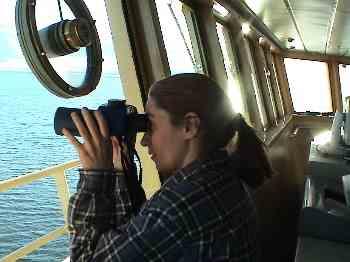2 February, 2004
The morning temperatures have been in the high teens and low twenties
Fahrenheit, cold enough to make sea ice. The winds have been
relatively calm and when we are in the southern most part of McMurdo
Sound, we are often breaking clear fresh ice. As we move around the
Sound we encounter ice of different age and origins. Some of the
smaller chunks of ice are annual ice, sea ice that was formed over
the last year and has broken due to the tides and wind. This ice is
much softer and when we hit it with the ship, it gives way easily and
makes a soft muffled sound as it hits the hull.
Fast ice is multi year ice that is normally frozen right up to the
shore. The "fast" refers to the ice being "held fast" in the same
position for many years. This ice breaks free into the open water
due to wind and wave action and has a completely different structure
than the annual ice. It is much harder than the annual ice, and the
sound that is made when it strikes the ship is like a metal hammer
pounding on the hull. Early in the day, penguins and seals could be
seen lounging on these ice flows. The penguin footprints
crisscrossed the ice forming beautiful random patterns in the snow.
There are large icebergs that have calved off of the glaciers. Their
ice is very old and has been formed over centuries from the
accumulation of snow, and the affect of pressure on the snow crystals
over time. As the snow gets thicker, it compresses the crystals to
form very clear ice. The oldest ice in the glacier and the bergs is
blue, but melts perfectly colorless. Over time the icebergs break
apart into smaller chunks of various sizes that are typically
referred to as bergy bits. Growlers are old berg pieces that have
large below water protrusions that aren't detectable until you are
right upon them.
In the process of doing our seismic survey, it has been very
important that we avoid the ice as much as possible. When the ice
strikes the hull, the ringing of the metal affects the data that we
collect from the sonar. Navigating through the ice causes the
streamers to curve changing the timing of the reflected signal and
reducing the reliability of the data collected. Moving through the
ice, the streamers can get caught on the ice and break it in pieces
or break it away from the ship. The ship's pilots often consult with
the scientists to confirm that the path that they choose through the
ice flows also provides the scientists with the best possible data.
Most times the pilots are able to find a route that gets good data
and is gives safe passage for the ship.
By early morning preparations were being made to deploy the single
channel streamer. The ET's and MT's were getting everything ready,
and the scientists were deciding on shot lines and away points for
the next couple of days.
At 9:50 AM the fire alarm sounded. Everyone left his or her
stations, headed for their survival gear, and then to the
03-conference room for roll call. Ashley Lowe was one of the first
to arrive and she began taking roll and having people sign into the
logbook. Within a few minutes everyone was in the conference room,
from the bunks or their duties, but the alarm was still ringing. It
stopped briefly, and then started again. This time there were seven
short rings and one long ring. This was the signal for abandon ship
drill. It rang a second time, and the Chief Mate came in explained
the drill.
He told us that in most cases, the crew has time to react to an
emergency that would cause the ship to be abandoned. Everyone should
be prepared to go to the safe area at that signal. The two lifeboats
on the ship are each capable of holding all the people on the ship.
The crew is divided between both lifeboats, as would the passengers
in an emergency. The Chief Mate wanted us to be aware that it was
important that we understand that the lifeboats can hold everyone.
In a real abandonment, most of the time the ship goes down in such a
way that only one lifeboat will be accessible. Knowing where to go
and being prepared is key to safety of everyone on the ship.
By12:00 noon the marine techs started deploying the single channel
steamer. At 12:00 PM the second watch started marine mammal
observations. At 12:10 a sonobuoy was deployed and the electronics
techs could hear whales detected by the buoy. The ramp up procedure
requires that we wait 20 minutes from the start of observations
before we start firing the air guns. At 12:25 PM observers could not
see any whales in the area. By that time, the sonobuoy was miles
away, and the exact distance the whales were from the ship could not
be determined. Since we could not see any marine mammals within a
one-mile visual radius, we begin shooting one gun at a time to start
the seismic collection. Within 15 minutes were are up to speed and
the guns are operating normally.
No marine mammals were observed within the concern radius and seismic
collection continued through the afternoon and evening.
--

Vladimir (2nd Mate), Terry Wilson and Robert Potter (3rd Mate) check ice conditions and navigation on the bridge

Cristina Millan keeps watch for marine mammals.

Contact the TEA in the field at
.
If you cannot connect through your browser, copy the
TEA's e-mail address in the "To:" line of
your favorite e-mail package.
|
